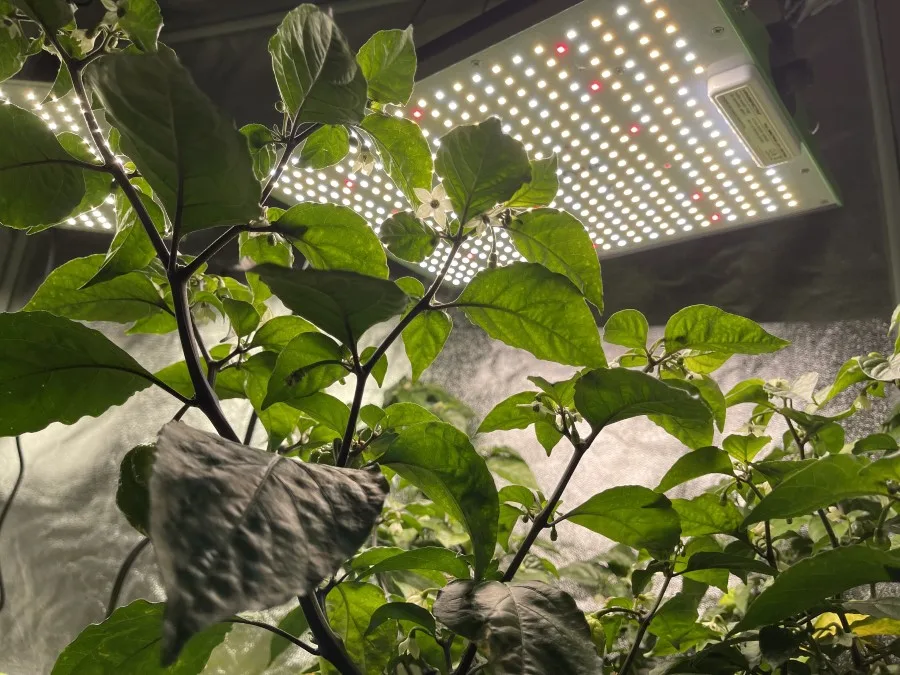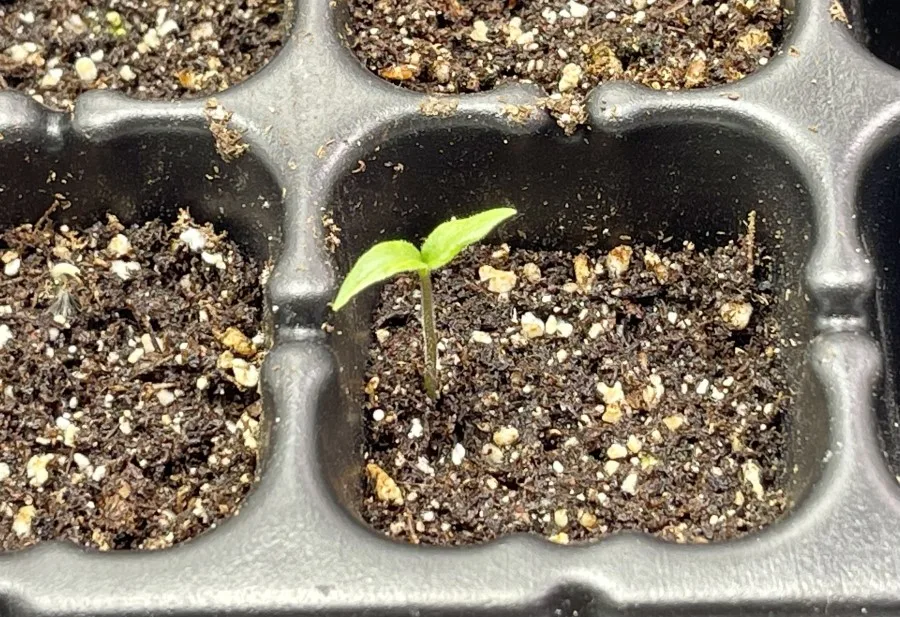As an Amazon Associate, I earn from qualifying purchases.
Oh no! Your Carolina Reaper plant is wilting! Or yellowing. Or dropping leaves. Or maybe it’s developing some suspicious-looking spots. What should you do?
For many gardeners, the adventure of growing the world’s hottest pepper involves a thrill beyond that of growing other plants. It’s playing with fire, and you don’t want your babies to die before you get a chance to taste the heat.
The good news is that Carolina Reapers, like most peppers, are surprisingly hardy plants. They’re great at communicating what they need; you just have to look in the right places.

How Do You Save a Dying Carolina Reaper Plant?
You can revive a dying Carolina Reaper plant by carefully inspecting it and, if needed, adjusting the amount of water, sunlight, and nutrients it receives. If these factors are optimal, your problems may be caused by soil pH, environmental temperature, pests, or disease. Treat early to save your plants!
This article will walk you through five common reasons why Carolina Reaper plants may be failing to thrive. We’ll share our top tips for how to tell which ailment your plant is suffering from and how to correct it.
How To Figure Out Why a Carolina Reaper Plant is Dying
Time to put on your detective hat and try to figure out what caused the issue with your pepper plants! Use this checklist and carefully examine your Carolina Reaper:
- Check the established leaves. Check for signs of pests, for spots that could indicate fungal or bacterial issues, and take note of the color. Check the new growth. Are the leaves forming properly without excessive curling or insect damage?
- Check the lower leaves. Is it only the lower leaves that are yellowing and falling off? If so, that’s probably a normal growth pattern and nothing to worry about.
- Check the fruit. Are your Reaper pods developing at the expected size and texture? Do the flowers turn into fruit after good fertilization?
- Check the soil. Feel the soil dryness with your finger or use a moisture meter. Lift the container. Is it heavy and soaked or light and dry? Is the soil mixed with perlite or another amendment that promotes drainage? Check the pH level and maybe even macronutrient levels using an at-home soil test kit.
- Check the environment. Is your plant in the wind or near cold drafts? Have there been sudden changes in the light source? Does the container allow for good drainage?
- Check the surrounding plants. Do the other nightshades in your garden have the same issues, or is it just this one plant?
Once you have your data, you can try to make a diagnosis.
So, let’s take a closer look at the most common reasons why Carolina Reaper plants die. We’ll relate these topics to all Carolina Reapers, whether grown indoors or outside, in the ground, or in a container.
1. Too Little or Too Much Water
Everyone knows that plants wilt if they don’t get enough water. But that doesn’t mean that you should automatically rush for the watering can if your pepper looks a bit floppy.
Overwatering can be just as dangerous for plants as underwatering, and it’s a harder problem to correct. So be sure to check the moisture level in the soil before soaking your plant. Your pepper is not ready for more water unless the top one to two inches (2.5 to 5 cms) of the soil are dry to the touch.
If you are interested in finding out more about watering your pepper plants, I have an entire post on how often you should be watering your pepper plants.
Signs of Underwatering Pepper Plants
The leaves on Carolina Reapers that aren’t getting enough water will sag and lose their shininess. Brown edges on leaves may indicate a sudden drought. It can be alarming to see at first, but as long as the leaves aren’t dried to a crisp, they’ll perk back up after a good drink.
If your Carolina Reaper pepper plant is fruiting, you can also tell if it’s getting enough water by the size and shape of the pods. If the pods are less than optimal size, or the “tail” on your peppers is curling, drying, and hardening, your plant may need more water.
If your pepper plant doesn’t revive within an hour or two after a thorough soaking, that probably wasn’t an issue—or the plant was too far gone. But even if it doesn’t appear to bounce back, don’t throw it away yet! If all the leaves fall off, but the stem is still green, it could still come back and sprout new, healthy leaves.
Signs of Overwatering Pepper Plants
Overwatered pepper plants can have dull floppy leaves too. This happens because the roots are rotted and not able to uptake water properly.
The roots also need oxygen to absorb nutrients, so if there’s too much water around the roots, they may not have access to oxygen, causing the leaves to turn yellow, and may lead to the plant dying if not taken care off.
Overwatering is most likely to happen in plants housed in pots that don’t drain properly, or that are growing in heavy clumpy soil. If there is algae growth on the top of your soil in containers, suspect overwatering.
How to Correct Watering Issues
If you’ve determined your Carolina Reaper plant is too dry, soak the soil thoroughly. It’s better to water deeply than often; make sure the entire root system gets a drink.
If the soil in your pot is too wet, wait for it to dry thoroughly before watering again. Take care to keep your Carolina Reaper pepper plant in a location with lots of air flow to prevent mold on the soil.
Once it’s doing a little better, you may want to transplant your Reaper to another pot that has better drainage, or a lighter soil mixture.

2. Too Much Sun or Not Enough Light
Can a pepper plant have too much sun? All domestic pepper plants, like other nightshades, are selectively bred from tropical plants native to very hot sunny climates. Carolina Reapers that have been acclimated to the outdoors can handle 12 hours of direct sunlight a day without a problem.
It’s very unlikely that too much sun is the cause of your pepper plant’s downturn, unless it’s coupled with extreme heat and not enough water.
Signs of Too Much Sunlight
A plant grown indoors under grow lights or a plant that has been recently transplanted outside could have trouble with too much light, causing sun scald on the leaves.
In the case of an indoor plant, this is usually caused by the lightbulb being too close or even in direct contact with the leaves. Sunscald in a seedling that was recently transplanted outdoors means it wasn’t hardened off fully before being exposed to the sun’s relentless rays.
Sunscald looks like large light brown or translucent patches, often on the tips or at the center of green leaves. These areas won’t heal; they usually disintegrate and cause holes in the leaves.
Signs of Not Enough Light
A pepper plant that’s not getting enough sunlight may grow disproportionately tall and leggy, not covered with foliage sufficient to match its height. It will be more susceptible to other stressors and may try to flower before the plant is mature in an attempt to reproduce before its demise.
How to Correct Lighting Issues
Carolina Reaper plants need a minimum of 6-8 hours of good quality light a day. This can either be direct sunlight or a full-spectrum grow light. Follow the grow light manufacturer’s directions regarding how high above your plants to place the light.
If your transplants got sun scald when you set them outdoors, they may be stunted for a while, but will probably make it. The plants will replace the scalded leaves with new growth as they adjust to their new environment. If you’re expecting extremely hot days, you may want to bring your pepper plants in, or provide it with shade to help it recover quickly.

3. Temperatures that are Too Hot or Too Cold
Carolina Reapers produce best in temperatures between 70-85° Fahrenheit (21-29°C). They have a slightly higher heat tolerance than sweet peppers but will still drop their blooms when it gets over 90°F (32°C).
Peppers will have stunted growth in soil temperatures below 60° F (15.5° C). You can test soil temperatures with a soil probe thermometer or a digital meat thermometer. Since Carolina Reapers are tropical plants, they will not survive hard frosts.
Signs of Temperatures Too Hot
Outdoor Carolina Reaper plants may wilt and eventually die if it gets too hot out, especially if it’s windy. Wind makes the water in the leaves evaporate faster than normal. This keeps the plant cool, but also risks dehydration.
Wilting in the middle of a hot summer day may not be cause for concern; it’s actually the plant’s way of protecting itself from the heat. However, you can provide water and shade to help it get through the day with minimal stress.
Signs of Temperatures Too Cold
If the soil temperature dips below 60° F (15.5° C), your Carolina Reaper may not be able to uptake phosphorus. This will cause some mottled purple coloring on the leaves.
If you leave your pepper plants out in temperatures below 32°F (0° C), they can get frostbite. Leaves suffering from frostbite will turn gray and die quickly. The entire plant won’t last more than a few days once the nighttime temperatures drop below freezing.
How to Correct Temperature Problems
If you have hot and windy days in the forecast, prepare to cover your Reaper plants with shade cloth or move containers to a shady spot in the afternoon. Make sure to soak the roots each morning. You can also spray some water on the leaves, so they’ll cool as it evaporates.
In the spring, don’t set Carolina Reaper transplants out in the garden until the fear of frost is past and the soil temperatures have warmed to at least 60° F (15.5° C) at night.
If your transplants are out in the cold and start to wave the purple flag of phosphorus deficiency, you can fertilize them with a very gentle dilution of a well-balanced fertilizer and take them back inside until it’s warm enough to set them out.
If you want to keep your peppers alive over the winter, carry your containers inside or dig up garden plants and place them in pots before the first frost. You might be able to save a Reaper that suffered from one night of frostbite, but it’s a lot easier to prevent it from happening.

4. Wrong Soil pH or Lack of Available Nutrients
Carolina Reaper plants do best in slightly acidic soil, with a pH level of 6 to 6.5. While more acidic soil can produce hotter peppers, pushing the pH too far in either direction will lead to nutrient deficiencies.
Signs of Nutrient Deficiencies in Carolina Reapers
Lack of nitrogen can cause stunted growth and yellow leaves.
Phosphorus deficiency will lead to small dark green or purplish leaves.
Potassium deficiency in Carolina Reapers manifests as brown-yellow leaf tips and curling at the edges of leaves, also with stunted overall growth and lower disease resistance.
There are many other micronutrients and minerals that Carolinas Reapers need in proper balance to grow and thrive. These include magnesium, zinc, calcium, and sulfur.
How to Correct pH and Nutrient Problems
If you start your Carolina Reaper pepper plants in rich loamy soil with lots of organic matter (like compost), you’re unlikely to run into nutrient deficiencies, at least in the first growing season. This soil will also probably have the right pH level for Carolina Reapers to thrive.
However, if you suspect nutrient deficiencies, begin by testing the soil pH level. Your soil can contain all the right nutrients, but without the right pH, your Reapers will not absorb those nutrients properly.
You can test your soil pH level with at-home soil test kits. Some of these kits will also test levels of the macronutrients Nitrogen (N), Phosphorus (P), and Potassium (K).
If you are looking to pick up a good high-quality pH meter, I recommend the Bluelab PENPH pH Pen which can be found at Amazon.com.
You can lower your soil pH level and make it more acidic by adding sulfur compounds, organic matter, or white vinegar. The easiest way to raise soil pH levels is to add garden lime. Once you’ve made the amendments, be sure to monitor the pH and nutrient levels regularly to make sure they don’t fall out of balance again.
If your interested in learning more about soil pH levels in soil, I have an entire post on how to measure and adjust soil pH levels.
5. Pests and diseases
A Carolina Reaper that is planted in rich, loamy soil, given necessary fertilizer, and growing in overall ideal conditions will be fairly resistant to pests and diseases. So, if you notice disease or a pest infestation, treat the problem with the appropriate spray, but don’t stop there.
You should also test the soil’s pH level and evaluate the overall care of your peppers, making sure nothing is stressing them that makes them more susceptible to disease and death.
Signs of Disease in Carolina Reaper Plants
One common and potentially devastating disease in peppers is called bacterial spot, caused by the pathogen Xanthomonas spp. This pathogen will rapidly multiply on foliage that is too wet for too long.
No pun intended, but it’s pretty easy to spot peppers suffering from this condition. The leaves will develop small round dark spots, possibly with yellow outlines, on the leaves and fruit.
Viruses in pepper plants are usually spread by aphids and may cause twisted, bumpy, mottled, or misshapen leaves and fruit.
Signs of Pest Pressure in Carolina Reapers
Common garden pests that could be causing your plants trouble include aphids, spider mites, and tomato hornworms. Pepper plants kept indoors in pots may suffer from whiteflies.
Aphids are tiny, soft-bodied sapsuckers that go around poking little holes in your pepper leaves and sucking the life-juice out of them. Sometimes they leave a sticky white substance behind, called honeydew, that may attract ants.
If you notice that your pepper plant is suddenly wilted, but it’s been getting plenty of water, check the base of the stem. If it’s been sliced through, that may be the work of a cutworm. If this happens, it might be too late to save the whole plant, but you can take a cutting and re-root it!
How to Correct Disease or Pest Problems in Carolina Reaper Plants
You can squash aphids or whiteflies by hand or spray them with a dish soap and vinegar solution, neem oil, or insecticidal soap.
Bacterial spot is harder to control. If you catch it early on, you can treat it with a copper-based spray. Did you know that Carolina Reapers can benefit from probiotics? Spraying your plants with beneficial bacteria can help combat pathogens.
Unfortunately, however, there are no treatments for viruses in peppers. Your best chance to prevent the issue from spreading to other plants is to destroy affected plants as soon as possible and sterilize or throw out the soil. Sterilize pots and garden tools that may have come in contact with the issue.
How to Prevent Disease or Pest Problems in Carolina Reaper Pepper Plants
Pests and diseases are difficult to control in pepper plants, but prevention can go a long way. Grow your peppers from seeds that you trust are treated or screened for disease or treat your own seeds with bleach or hot water (Make sure to do this carefully, as too much bleach or hot water could prevent germination).
If you’re growing Carolina Reapers in the ground outdoors, always transplant them to a different area of the garden than where you had peppers (or other nightshades like tomato or eggplant) last year.
You can also purchase beneficial insects, such as ladybugs or wasps that prey on aphids, and introduce them to your garden.
Closing Thoughts
Carolina Reaper plants that are truly dying will usually drop quickly. But these fiery plants can soldier on for a long time in less-than-ideal conditions.
If your pepper plant is struggling, we hope these tips will help you pinpoint and treat the issue, kindling that spark of life in your Carolina Reaper plant anew.
